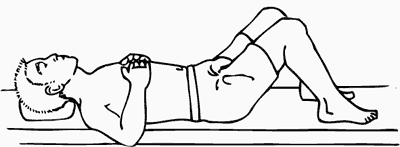Probably the first people who began to master these exercises were convalescent or bedridden people. The effectiveness of these exercises has been proven in the treatment of most chronic diseases. Exercises can also be performed by those who simply do not want to get out of bed. If this is your case, then all the exercises described in this book can be done while lying down.
Chinese sources indicate that for weakened people it is preferable to combine sitting and lying postures rather than using only lying postures. Still, the best option seems to be a combination of all types of postures - standing, sitting and lying down.
There are two main types of recumbent forms: supine and side decubitus. The prone position is not taught. This week you will learn to lie on your back.
You lie down on the bed, floor or any other flat surface and place a small pillow under your head.
There are four posture options, each of which can be used for meditation or breathing exercises. When working on this section, I took into account the recommendations of Chinese manuals.

A. Lying down, arms along the body
1. Lie on your back with a pillow under your head.
2. Legs extended, heels together.
3. Hands lie along the body.
4. Fingers slightly apart; the tips of the thumbs touch the thighs.
5. Relax your shoulders and elbows.
This form is especially good for the “third treasure” meditation practice “mind stealing” (“mindless mind”). It is also recommended for those suffering from neuroses and palpitations.
B. Lying down, hands on stomach
1. Lie on your back with a pillow under your head.
2. Hands lie along the body.
3. Men: place your left palm on the navel and cover it with your right. Women: Place your right palm on your navel and cover it with your left.
This form is recommended when performing “abdominal breathing”. It can be used for increased fatigue and depression.

B. Lying down, hands on stomach, legs crossed
1. Lie on your back as in pose “B”, but cross your legs (left over right).
2. After a while, switch your legs.
3. Squint your eyes and look into the distance over your toes with a defocused gaze.
This form is also recommended for fatigue and depression.
D. Lying down, hands on chest, knees pulled up
1. Lie on your back with a pillow under your head.
2. Place your hands on your upper chest, palms down, fingers slightly apart.
3. Bend your knees at an angle of 90°, feet resting on the surface.
4. Relax your whole body and imagine that you are floating on water.

Recommended for disorders of the autonomic nervous system.
Next week you'll be introduced to side lying poses, but until then, don't roll over (humor).



